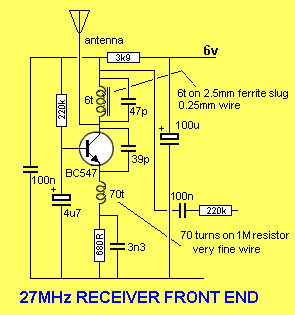

I know this circuit is an oscillator circuit and it senses another signal of same frequency, but I don't understand
- the calculation behind it, and
- the reason for emitter inductor,
- 3.9k collector resistor and
- others.
Can someone please show me the calculations for this circuit?
I made one myself but I am tired of tuning it. It only receives signal within few centimeters. It receives not only my 27 MHz toy car remote signal but any kind of signal, e.g: walkie talkie signal.
here is the link for that circuit: http://www.talkingelectronics.com/projects/27MHz%20Transmitters/27MHzLinks-1.html
They explained the circuit but didn't show the calculation, and they also didn't mention the inductor value.
#So many ANSWERS in so little TIME. This is my first post on this site, and all of you made me feel warm, i am really honored. Thank you so much guys, and please forgive me if i said anything that hurts you. Even if i haven't found any suitable answer but i really found something that is more importent than the answer, you all waste your time for me, that's all i really needed, THANK YOU, THANK YOU AGAIN. If you know any place where i can start learning RF all over again, then feel free to mention it.
